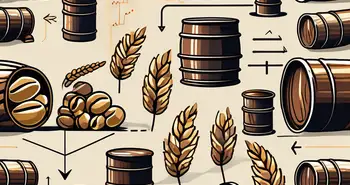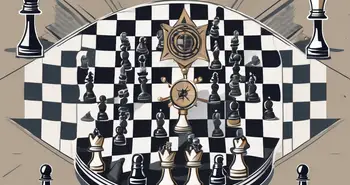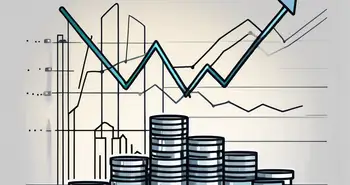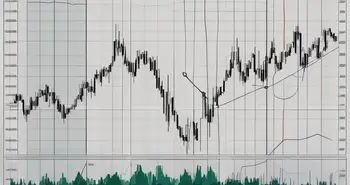Article Contents
The Concept of Backwardation in Futures Trading
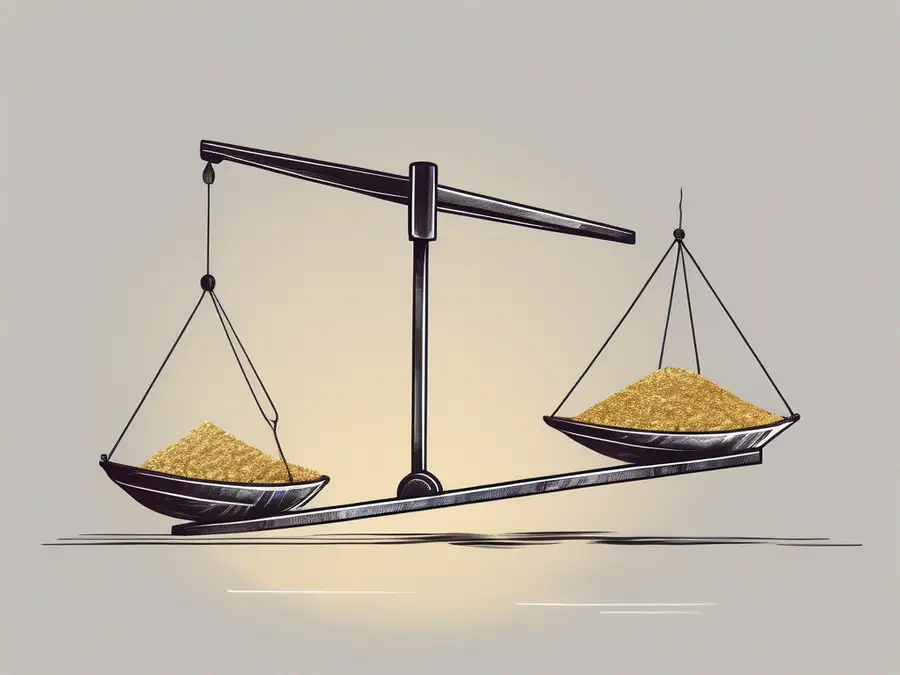
In the world of futures trading, there are numerous terms and concepts that need to be understood in order to navigate the market successfully. One such concept is backwardation. In this article, we'll delve into the definition, causes, effects, and even strategies for trading in backwardation. So, let's jump right into it and enhance our understanding of this intriguing phenomenon.
Defining Backwardation in the Context of Futures Trading
Before we can understand backwardation, we need to grasp the basics of futures trading. Futures contracts are agreements to buy or sell commodities, securities, or currencies at a predetermined price and date in the future. Backwardation refers to a situation where the price of a futures contract is lower than the expected spot price at the contract's expiry.
Imagine a scenario where the current market price for oil is $60 per barrel, and the futures contract for delivery in three months is priced at $58 per barrel. This is a clear example of backwardation because, in theory, investors are willing to pay less for the commodity in the future than its current market value.
The Role of Backwardation in Futures Contracts
Backwardation plays a significant role in futures contracts by offering certain benefits to different market participants. For producers or sellers of commodities, backwardation allows them to lock in a specific price, protecting them from potential price declines in the future. This can be particularly advantageous for farmers who grow crops that are subject to unpredictable weather conditions or other external factors that can affect prices.
On the other hand, for speculators, backwardation provides potential profit opportunities when buying futures contracts below the expected spot price. These speculators carefully analyze market trends and make informed decisions to take advantage of the price discrepancy between the futures contract and the expected spot price. By purchasing contracts at a lower price and selling them at a higher spot price, they can potentially earn a profit.
Key Terms Related to Backwardation
While understanding backwardation is crucial, it's equally important to familiarize ourselves with other terms associated with this phenomenon. Contango is the opposite of backwardation and occurs when the futures price exceeds the expected spot price. This situation often arises when there is an expectation of future price increases or when the cost of storing the commodity becomes significant.
Another term worth mentioning is roll yield, which represents the gain or loss that occurs when investors roll over their expiring futures contracts into new ones. This process involves closing out the existing contract and simultaneously opening a new one with a later expiration date. Roll yield can be positive or negative, depending on the price difference between the expiring contract and the new contract. Traders and investors closely monitor roll yield as it can significantly impact their overall returns.
By understanding these key terms related to backwardation, market participants can navigate the complex world of futures trading with more confidence and make informed decisions based on the prevailing market conditions.
The Causes and Effects of Backwardation
Now, let's delve into the factors that lead to backwardation and the impact it has on futures prices.
Factors Leading to Backwardation
Backwardation can stem from various factors, such as supply and demand dynamics, storage costs, interest rates, and market sentiment. For example, if there is a shortage in the supply of a particular commodity, buyers may be willing to pay a premium for immediate delivery, thereby driving prices into backwardation.
Additionally, storage costs can influence backwardation. If it is cheaper to store or hold a particular commodity during a given period, investors may choose to roll over their contracts, resulting in backwardation as the market anticipates lower storage costs in the future.
Impact of Backwardation on Futures Prices
Backwardation can significantly influence the pricing of futures contracts. When a market is in backwardation, it implies that market participants anticipate lower prices in the future. As a result, futures prices are pushed down relative to the expected spot price. This inverse relationship between futures prices and backwardation can provide lucrative opportunities for astute traders who are able to capitalize on these pricing discrepancies.
The Relationship between Backwardation and Contango
It is important to distinguish between backwardation and its counterpart, contango. While backwardation occurs when futures prices are lower than expected spot prices, contango refers to a situation where futures prices exceed the expected spot prices. Understanding and identifying whether a particular market is in backwardation or contango is crucial for formulating trading strategies.
Distinguishing Between Backwardation and Contango
In practice, distinguishing between backwardation and contango can be achieved by comparing the futures prices to the expected or spot prices. If the futures prices are lower than the expected or spot prices, we're in backwardation. Conversely, if the futures prices exceed the expected or spot prices, we're dealing with contango.
The Market Conditions for Backwardation and Contango
Market conditions that favor backwardation or contango can vary based on supply and demand dynamics, storage costs, interest rates, and overall market sentiment. Different commodities and financial instruments might exhibit varying tendencies towards one of these two pricing scenarios. It's crucial to stay informed about these conditions before engaging in futures trading strategies.
Strategies for Trading in Backwardation
Now that we have a solid grasp of backwardation, it's time to explore some strategies for successfully trading in this market condition.
Risk Management in Backwardation
As with any investment strategy, risk management should be a priority when trading in backwardation. It's important to set clear risk limits, diversify your portfolio, and closely monitor market conditions. By implementing a disciplined approach to risk management, you can maximize your chances of success and safeguard your capital.
Profit Opportunities during Backwardation
Backwardation presents unique profit opportunities for traders willing to capitalize on pricing inefficiencies. By buying futures contracts at lower prices than the expected spot prices, savvy investors can potentially profit from the convergence of futures and spot prices during the contract's lifespan.
The Future of Backwardation in Futures Trading
As the futures market continues to evolve, it raises questions about the future of backwardation and its implications for traders.
Predicting Backwardation Trends
Predicting backwardation trends can be challenging, as they are influenced by various factors that can change rapidly. Utilizing data analysis, market research, and staying abreast of economic indicators can help traders gain insights into potential instances of backwardation and inform their trading decisions.
The Role of Technology in Backwardation Forecasting
Advancements in technology have revolutionized the way traders analyze and predict market trends. From sophisticated algorithms to artificial intelligence, technology has played a pivotal role in enhancing backwardation forecasting capabilities. By leveraging these tools, traders can gain a competitive edge and make more informed trading decisions.
FAQ – Understanding Backwardation in Futures Trading
1. What is backwardation?
Backwardation refers to a situation where the price of a futures contract is lower than the expected spot price at the contract's expiry. It can be caused by factors such as supply and demand dynamics, storage costs, interest rates, and market sentiment.
2. How does backwardation affect futures prices?
In backwardation, futures prices are pushed down relative to the expected spot price. This can create profit opportunities for traders who are able to buy futures contracts below the expected spot price.
3. What is the difference between backwardation and contango?
Backwardation occurs when futures prices are lower than expected spot prices, while contango refers to a situation where futures prices exceed the expected spot prices.
4. How can traders profit from backwardation?
Traders can potentially profit from backwardation by buying futures contracts at lower prices than the expected spot prices and capitalizing on the convergence of futures and spot prices during the contract's lifespan.
5. What role does technology play in backwardation forecasting?
Technology, such as data analysis, market research tools, algorithms, and artificial intelligence, has greatly enhanced backwardation forecasting capabilities. By leveraging these tools, traders can gain insights into potential instances of backwardation and make more informed trading decisions.
In conclusion, understanding the concept of backwardation in futures trading is crucial for anyone looking to navigate the market successfully. From grasping the definition and causes of backwardation to exploring trading strategies and analyzing the future implications, a well-rounded understanding of this phenomenon can provide invaluable insights. So, keep learning, stay informed, and happy trading!
Ready to take your futures trading to the next level with the insights on backwardation you've just gained? Join Morpher, the revolutionary trading platform that leverages blockchain technology for a seamless, fee-free trading experience. With Morpher, you can trade a variety of asset classes, from stocks and cryptocurrencies to unique markets like NFTs, all with fractional investing, short selling, and up to 10x leverage. Sign up now to enjoy the benefits of a platform that offers infinite liquidity and a unique trading experience with Virtual Futures. Don't miss out—Sign Up and Get Your Free Sign Up Bonus today and transform the way you trade!

Disclaimer: All investments involve risk, and the past performance of a security, industry, sector, market, financial product, trading strategy, or individual’s trading does not guarantee future results or returns. Investors are fully responsible for any investment decisions they make. Such decisions should be based solely on an evaluation of their financial circumstances, investment objectives, risk tolerance, and liquidity needs. This post does not constitute investment advice.

Painless trading for everyone
Hundreds of markets all in one place - Apple, Bitcoin, Gold, Watches, NFTs, Sneakers and so much more.

Painless trading for everyone
Hundreds of markets all in one place - Apple, Bitcoin, Gold, Watches, NFTs, Sneakers and so much more.



